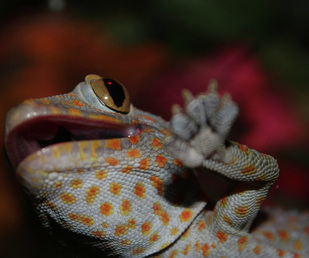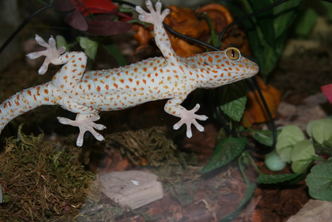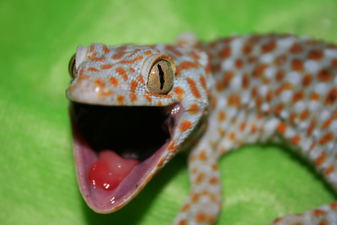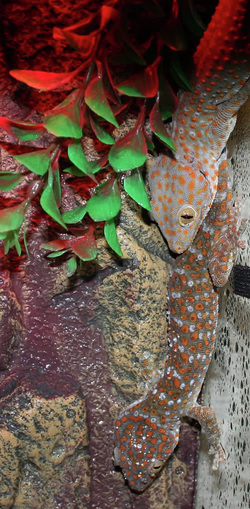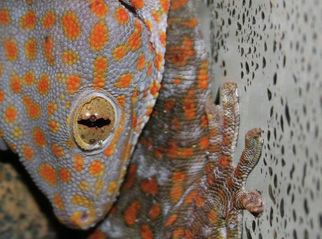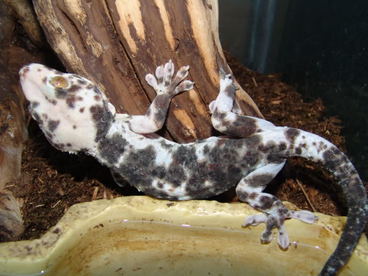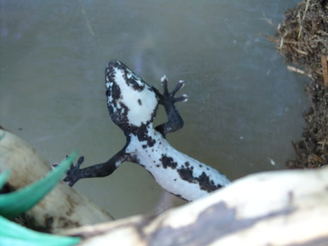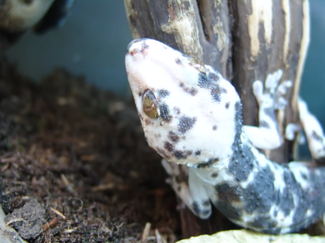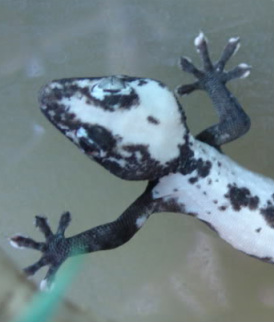TOKAY GECKO CARE
The Tokay Gecko (Gekko gecko)
WRITTEN BY:
PHOTOS: Body of Article: Aysha O'Brien
Morphs and Cover Photos: The generous members of The Alberta Reptile Society
WRITTEN BY:
PHOTOS: Body of Article: Aysha O'Brien
Morphs and Cover Photos: The generous members of The Alberta Reptile Society
INTRODUCTION
The Tokay Gecko is a well known species among Herpetologists, They are well known as they are Beautiful creatures, And also extremely aggressive. People who own them often say how impossible they are to tame, Or even care for.
This Care sheet is one with a twist, Simply as I know it's possible from first hand experience, that not all these beautiful geckos are not what you think they are. As they say they are the “Pit bull” of all geckos. Now I am also a believer that the pit bull is also an angel in disguise, only difference is they are often in the wrong hands!
Unfortunately most of the population in the UK are Wild caught specimens and you have to take into consideration they have gone from there home, packed up, shipped off, and left for days possibly with out food, and then end up in a pet store, with strange animals tapping the glass, and being handled. So if your new friend is upset and doesn't eat, give him time, he's settling in! The poor thing is stressed to high heaven and if that was you, just think how you would be feeling being stuck in a cage after being free! It's up to you to make the gecko think “hey this isn't to bad, I get fed daily, and it,s clean, and no more pesky mites to annoy me!
Also be prepared for the possible trips to the vets for some treatments to clear mites, and worms, More in to this later so keep reading!
ORIGINS
The Tokay gecko originates from a wide range of area, and can be found in Northeast India, Southeast Asia, Indonesia, New guinea and the Philippines. The Tokay Gecko has also been Introduced as an invasive species to Belize, Florida, Texas, Hawaii and some Caribbean islands.
The natural habitat of this arboreal species is in the trees and cliffs of the tropical rain forest. The can be found dwelling in and around human settlements where they can find easy shelter and are often valued for there insect pest control!
The Tokay Gecko is a well known species among Herpetologists, They are well known as they are Beautiful creatures, And also extremely aggressive. People who own them often say how impossible they are to tame, Or even care for.
This Care sheet is one with a twist, Simply as I know it's possible from first hand experience, that not all these beautiful geckos are not what you think they are. As they say they are the “Pit bull” of all geckos. Now I am also a believer that the pit bull is also an angel in disguise, only difference is they are often in the wrong hands!
Unfortunately most of the population in the UK are Wild caught specimens and you have to take into consideration they have gone from there home, packed up, shipped off, and left for days possibly with out food, and then end up in a pet store, with strange animals tapping the glass, and being handled. So if your new friend is upset and doesn't eat, give him time, he's settling in! The poor thing is stressed to high heaven and if that was you, just think how you would be feeling being stuck in a cage after being free! It's up to you to make the gecko think “hey this isn't to bad, I get fed daily, and it,s clean, and no more pesky mites to annoy me!
Also be prepared for the possible trips to the vets for some treatments to clear mites, and worms, More in to this later so keep reading!
ORIGINS
The Tokay gecko originates from a wide range of area, and can be found in Northeast India, Southeast Asia, Indonesia, New guinea and the Philippines. The Tokay Gecko has also been Introduced as an invasive species to Belize, Florida, Texas, Hawaii and some Caribbean islands.
The natural habitat of this arboreal species is in the trees and cliffs of the tropical rain forest. The can be found dwelling in and around human settlements where they can find easy shelter and are often valued for there insect pest control!
DESCRIPTION
The Tokay Gecko is the second largest gecko in the world, First being The New Caledonian Giant Gecko which can reach 14.5”. So, the Tokay isn't that far off! Adult males can reach 12-14” in total length, nearly 1 foot in length (Nose to tail tip). For this reason it's a decision to own one not to be taken lightly.
Often the Tokay gecko is offered as a good first Gecko, along with the Leopard geckos and the Crested geckos. As this is often done in the practice there are many who end up re-homed due to either not the right research done OR simply...they are to aggressive and the owner is scared to even go near them!
Female Tokay's tend to be slightly smaller averaging 8-10” long. Tokay's tend not to be weighed due to their temperaments. How ever, if you can it is good to be able to keep a good record simply as a Tokay should be bulky and weight around 5-7 ounces, But bigger males tend to achieve closer weights to 11.5 ounces. It can take up to two years for a tokay gecko to reach its full adult size.
Male Tokay geckos are a Blue-Grey body colour that varies from a reddish-orange to whitish-yellow. Females are similar how ever tend to not be as brightly coloured as the males, but is dependant on each gecko!
Each gecko has the ability to change its skin colour; darker to blend with its surroundings. It is also a good indication on how the gecko is feeling, So one way to tell whether to bother it or not!
Also both have the ability to bite, and are quite powerful for their size! Great things come in small packages hey!
The Tokay's have an average life span of 7-10 years. In captivity it is known for them to live up to 20 years with the adequate care they require.
ENCLOSURE/HOUSING
A glass aquarium, Or terrarium from your local pet store is acceptable. Also it has been known for them to be kept in plastic tubs (RUBs) these are very good for being able to check, and keep clean as often as you like! A single Tokay can be kept in a standard 20 gallon tall/high aquarium (24”L x 12”W x 16” H). Being arboreal the taller the better! and the larger tanks are recommended, Exo-terra offer excellent terrariums, as do Komodo who are a new company. So think about what you are buying, a taller tank will always be a winner! Hard to come by but well worth looking for! Do not use Terrariums with screened sides as these can damage the Tokay's delicate toes!
One male and several females can be housed together in larger tanks. Male Tokay's are very territorial and will fight another male in the enclosure so do try not to keep them together, and if you are not sure, get somebody who knows how to sex these geckos to make sure for you.
Tokay's love to hide, so the more foliage you can offer the better for the gecko, And the less stressed out he will be. This could be cork bark, Toilet roles, Plants, Specially made hides you can buy from pet stores, however these can be expensive. It is always worth being imaginative!
Thick logs rather than skinny ones as they are large geckos and wont really use the skinny ones, and also vines you can purchase from stores, these can help give the natural effect.
HEATING AND LIGHTING
Day time temperatures should be maintained between 75f-80f with a night time drop to 60-65f. Tokay geckos are hardy animals so if temps are up and down there is no need to panic as in the wild its never perfect, now is it!
Tokay geckos are nocturnal so UVB bulbs are not needed however, you can always give them the option so long as they have the opportunity to hide away from it and be in the dark, due to having very sensitive eyes.
You can use a heat mat to keep the temps up, Or if you prefer a Bulb to heat it. Using these methods you should ALWAYS use a stat to control the temps as this could cause the units to over heat the enclosures and your geckos could perish so its always worth spending that extra money to keep them safe! Your tokay will always move away from the hot end in order to cool back down so make sure you give them this option.
SUBSTRATE
The best substrate to use is the ground coconut fibre material. You can get this and similar from reptile stores, and on the net. You can also use newspaper, or paper towel which is even easier to keep clean. It's all personal preference. You could also use Top soil for your enclosure, especially good if you are wanting a natural set up with real plants!
Coconut fibre is provided to you in dried, compressed blocks from your pet store. All you do is add some warm water to it and wait. It expands as it absorbs the water you have added to it. This material is non toxic, Small particles will not choke your gecko or cause impaction if swallowed and it holds moisture to maintain the high humidity levels your gecko requires.
HUMIDITY
Tokay geckos natural habitat is tropical rain forests as said above, with high humidity levels. In captivity, you should try to maintain relative humidity levels of 40-80%. This can easily be achieved and maintained by keeping the substrate moistened (But not wet) daily misting, and the use of a large shallow water dish. Potted plants also help maintain desired humidity.
Do not let humidity drop below 40%. Failure to maintain proper humidity levels can lead to health problems, Primarily incomplete sheds. This can be dangerous to the geckos delicate foot pads and can result in the inability to cling to surfaces of which they spend 95% of their lives off the floor. It could also lead to infections or other damage to their toes.
PLANTS
POTHOS - (Epipremnum aurem) This is a commonly available beginner houseplant that comes in 3 main color varieties: golden, variegated and Jade. Pothos plants prefer bright indirect light, but can tolerate lower light conditions. Water when top inch of soil gets dry, usually about once a week. Pothos is a low growing vining plant. Periodically prune the vines back to maintain desired size or shape. Pothos can be easily propagated by rooting cuttings in water.
SNAKE PLANT- (Sansevieria sp.) Another hardy plant that grows clumps of vertical sword-like leaves. Snake plants prefer moderate to bright light and watering every 7-10 days, but do not over water. Sansevieria likes to be pot bound and can be propagated by separating leaf clumps from the base or from cuttings.
MAINTENANCE
In order to maintain an attractive, healthy environment for your gecko, a regular cleaning regimen needs to be done.
Tokay's generally have voracious appetites and are aggressive eaters. Ideally, your Ttokay should be fed small amounts frequently as opposed to all in one go, mass feedings that are irregular. All live food should be “Gut loaded” (this can be achieved by feeding crickets specially made cricket formulas) which are high in calcium and also just adding porridge oats, with a daily spray or cricket gel to keep them hydrated. Its not just your reps you have to keep in top conditions their food also needs a good life to give your reptiles a good life!
T-REX offer a good product called Calcium Plus. It's in pellet form. No need to try mix it with anything. Just read the instructions and away you go!.
LIVE FOODS
CRICKETS/LOCUSTS – These should be fed as the main diet for your Tokay. They are available from all good pet stores, in a range of sizes both large and small. Adult Tokay's can easily eat large crickets/locusts, Some very young sub adults and newly hatched Tokay's may require smaller or even pin head crickets/Locusts (extra small).
PINKY/FUZZY MICE – An adult Tokay gecko can be fed “pinkie” mice occasionally to supplement their diet. Don't try to feed too large a prey item to your Tokay. They may not be able to swallow it, and may choke, OR you are left with having to leave them till they decide to let go. Which adds bacteria to your enclosure, as this may take time. These can be purchased already culled and frozen in pet stores. It is up to the owner if they wish to breed mice and cull them selves. Its a frowned upon practice in the UK, however, it is not illegal. It is only illegal for a store to sell pet mice as live food. So sorry you would have to breed them you selves if thats what you wish to do.
MEALWORMS AND WAXWORMS – These items are not very nutritious and should not used as a mainstay to feed your gecko. They are fine with a varied diet. Wax worms are high in fat, these are good if you wish to gain weight on your gecko for breeding, or if its a skinny one from a store due to just coming in.
PHENIX WORMS – Hard to come by, and are quite small, FULL in calcium. Excellent if your gecko is gravid, or or you are breeding.
DUBIA ROACHES – Can also be fed as a staple diet. Again, require gut loading. Brilliant breeders, But expensive to start of a colony. Adults reach the size of 4”, males have wings, and females don't. How ever “eww” they are, they don't smell, they cannot climb, Males don't fly. The young are perfect for other reptiles, and adults are perfect for the larger reptiles. Have soft outer shells unlike meal worms so are great. And they don't jump and cant escape! PERFECT!
The Tokay Gecko is the second largest gecko in the world, First being The New Caledonian Giant Gecko which can reach 14.5”. So, the Tokay isn't that far off! Adult males can reach 12-14” in total length, nearly 1 foot in length (Nose to tail tip). For this reason it's a decision to own one not to be taken lightly.
Often the Tokay gecko is offered as a good first Gecko, along with the Leopard geckos and the Crested geckos. As this is often done in the practice there are many who end up re-homed due to either not the right research done OR simply...they are to aggressive and the owner is scared to even go near them!
Female Tokay's tend to be slightly smaller averaging 8-10” long. Tokay's tend not to be weighed due to their temperaments. How ever, if you can it is good to be able to keep a good record simply as a Tokay should be bulky and weight around 5-7 ounces, But bigger males tend to achieve closer weights to 11.5 ounces. It can take up to two years for a tokay gecko to reach its full adult size.
Male Tokay geckos are a Blue-Grey body colour that varies from a reddish-orange to whitish-yellow. Females are similar how ever tend to not be as brightly coloured as the males, but is dependant on each gecko!
Each gecko has the ability to change its skin colour; darker to blend with its surroundings. It is also a good indication on how the gecko is feeling, So one way to tell whether to bother it or not!
Also both have the ability to bite, and are quite powerful for their size! Great things come in small packages hey!
The Tokay's have an average life span of 7-10 years. In captivity it is known for them to live up to 20 years with the adequate care they require.
ENCLOSURE/HOUSING
A glass aquarium, Or terrarium from your local pet store is acceptable. Also it has been known for them to be kept in plastic tubs (RUBs) these are very good for being able to check, and keep clean as often as you like! A single Tokay can be kept in a standard 20 gallon tall/high aquarium (24”L x 12”W x 16” H). Being arboreal the taller the better! and the larger tanks are recommended, Exo-terra offer excellent terrariums, as do Komodo who are a new company. So think about what you are buying, a taller tank will always be a winner! Hard to come by but well worth looking for! Do not use Terrariums with screened sides as these can damage the Tokay's delicate toes!
One male and several females can be housed together in larger tanks. Male Tokay's are very territorial and will fight another male in the enclosure so do try not to keep them together, and if you are not sure, get somebody who knows how to sex these geckos to make sure for you.
Tokay's love to hide, so the more foliage you can offer the better for the gecko, And the less stressed out he will be. This could be cork bark, Toilet roles, Plants, Specially made hides you can buy from pet stores, however these can be expensive. It is always worth being imaginative!
Thick logs rather than skinny ones as they are large geckos and wont really use the skinny ones, and also vines you can purchase from stores, these can help give the natural effect.
HEATING AND LIGHTING
Day time temperatures should be maintained between 75f-80f with a night time drop to 60-65f. Tokay geckos are hardy animals so if temps are up and down there is no need to panic as in the wild its never perfect, now is it!
Tokay geckos are nocturnal so UVB bulbs are not needed however, you can always give them the option so long as they have the opportunity to hide away from it and be in the dark, due to having very sensitive eyes.
You can use a heat mat to keep the temps up, Or if you prefer a Bulb to heat it. Using these methods you should ALWAYS use a stat to control the temps as this could cause the units to over heat the enclosures and your geckos could perish so its always worth spending that extra money to keep them safe! Your tokay will always move away from the hot end in order to cool back down so make sure you give them this option.
SUBSTRATE
The best substrate to use is the ground coconut fibre material. You can get this and similar from reptile stores, and on the net. You can also use newspaper, or paper towel which is even easier to keep clean. It's all personal preference. You could also use Top soil for your enclosure, especially good if you are wanting a natural set up with real plants!
Coconut fibre is provided to you in dried, compressed blocks from your pet store. All you do is add some warm water to it and wait. It expands as it absorbs the water you have added to it. This material is non toxic, Small particles will not choke your gecko or cause impaction if swallowed and it holds moisture to maintain the high humidity levels your gecko requires.
HUMIDITY
Tokay geckos natural habitat is tropical rain forests as said above, with high humidity levels. In captivity, you should try to maintain relative humidity levels of 40-80%. This can easily be achieved and maintained by keeping the substrate moistened (But not wet) daily misting, and the use of a large shallow water dish. Potted plants also help maintain desired humidity.
Do not let humidity drop below 40%. Failure to maintain proper humidity levels can lead to health problems, Primarily incomplete sheds. This can be dangerous to the geckos delicate foot pads and can result in the inability to cling to surfaces of which they spend 95% of their lives off the floor. It could also lead to infections or other damage to their toes.
PLANTS
POTHOS - (Epipremnum aurem) This is a commonly available beginner houseplant that comes in 3 main color varieties: golden, variegated and Jade. Pothos plants prefer bright indirect light, but can tolerate lower light conditions. Water when top inch of soil gets dry, usually about once a week. Pothos is a low growing vining plant. Periodically prune the vines back to maintain desired size or shape. Pothos can be easily propagated by rooting cuttings in water.
SNAKE PLANT- (Sansevieria sp.) Another hardy plant that grows clumps of vertical sword-like leaves. Snake plants prefer moderate to bright light and watering every 7-10 days, but do not over water. Sansevieria likes to be pot bound and can be propagated by separating leaf clumps from the base or from cuttings.
MAINTENANCE
In order to maintain an attractive, healthy environment for your gecko, a regular cleaning regimen needs to be done.
- Daily spot cleanings to collect feces from the walls and substrate.
- Daily cleaning and refilling of the water dish
- Daily misting of enclosure to maintain the humidity required (40-80%).
- Replace substrate every three months or sooner, as needed.
- Cork bark tubes or other decorations that have become soiled can be removed from the enclosure and sprayed with a mild bleach solution (5% bleach 95% water). Rinse them under warm water until you can no longer smell any bleach residue and allow to dry before reintroducing to the tank.
Tokay's generally have voracious appetites and are aggressive eaters. Ideally, your Ttokay should be fed small amounts frequently as opposed to all in one go, mass feedings that are irregular. All live food should be “Gut loaded” (this can be achieved by feeding crickets specially made cricket formulas) which are high in calcium and also just adding porridge oats, with a daily spray or cricket gel to keep them hydrated. Its not just your reps you have to keep in top conditions their food also needs a good life to give your reptiles a good life!
T-REX offer a good product called Calcium Plus. It's in pellet form. No need to try mix it with anything. Just read the instructions and away you go!.
LIVE FOODS
CRICKETS/LOCUSTS – These should be fed as the main diet for your Tokay. They are available from all good pet stores, in a range of sizes both large and small. Adult Tokay's can easily eat large crickets/locusts, Some very young sub adults and newly hatched Tokay's may require smaller or even pin head crickets/Locusts (extra small).
PINKY/FUZZY MICE – An adult Tokay gecko can be fed “pinkie” mice occasionally to supplement their diet. Don't try to feed too large a prey item to your Tokay. They may not be able to swallow it, and may choke, OR you are left with having to leave them till they decide to let go. Which adds bacteria to your enclosure, as this may take time. These can be purchased already culled and frozen in pet stores. It is up to the owner if they wish to breed mice and cull them selves. Its a frowned upon practice in the UK, however, it is not illegal. It is only illegal for a store to sell pet mice as live food. So sorry you would have to breed them you selves if thats what you wish to do.
MEALWORMS AND WAXWORMS – These items are not very nutritious and should not used as a mainstay to feed your gecko. They are fine with a varied diet. Wax worms are high in fat, these are good if you wish to gain weight on your gecko for breeding, or if its a skinny one from a store due to just coming in.
PHENIX WORMS – Hard to come by, and are quite small, FULL in calcium. Excellent if your gecko is gravid, or or you are breeding.
DUBIA ROACHES – Can also be fed as a staple diet. Again, require gut loading. Brilliant breeders, But expensive to start of a colony. Adults reach the size of 4”, males have wings, and females don't. How ever “eww” they are, they don't smell, they cannot climb, Males don't fly. The young are perfect for other reptiles, and adults are perfect for the larger reptiles. Have soft outer shells unlike meal worms so are great. And they don't jump and cant escape! PERFECT!
VITAMIN AND MINERAL SUPPLEMENTATION
Powdered supplements are the most commonly used and typically come in separate containers: Vitamins and calcium supplement. Nutrobal is the vitamins, and Calypso is the Calcium both are widely used by herpetologists across the globe.
They are used to “dust” food items prior to feeding for maximum nutritional value. Dust your live food with calypso 3-4 days a week, And dust with nutrobal once. Regardless what some stores say You NEED them both. They both do what they are meant to to keep your reptiles healthy. Your gecko does not need to be fed every day of the week, Its up to the keeper, Just remember in the wild they don't eat every Day/Night so one day with out food wont hurt will only keep them interested.
WATER
These are a number of ways to provide drinking water for your geckos.
WATER BOWL – A large shallow bowl provides a constant supply of clean drinking water for your tokay, How ever you may notice the geckos never really drink from it. This is due to being able to hydrate from daily misting and just licking the glass, or them selves (i.e licking their eyes).
MISTING – This can be done about 2x daily to maintain humidity, and the geckos may lick the water droplets off the glass and other surfaces (so keep your tank clean!). Most Tokays will learn to drink from a dish or may never learn due to being wild caught. For this reason they need multiple options in order to hydrate.
DIET – Items can be placed on the screen top and allowed to drip in to the terrarium. A cup with a small hole in the bottom will also work. You can also purchase drips from reptile stores, and the internet.
BREEDING YOUR TOKAY
SEXING
Identifying the sex of Tokay geckos is fairly easy. Male tokay's tend to be larger, thicker and have wider, more angular heads than females. Male Tokay geckos typically have brighter grey and blue base colours while females tend to be darker grey and brown base colours.
The most definitive way of sexing them is to check underneath between their rear legs and just above the vent for a line of pores. Adult male Tokay's have a very pronounced series of pores that form a somewhat V-shaped line or ridge that may have tiny, waxy protrusions. It should be very noticeable in mature males. Female tokay geckos also have these pores, but they are not as pronounced or obvious.
Never try to keep more than one male tokay in one enclosure. Tokay geckos are very territorial and males will fight with each other resulting in injury or death. Several females may be kept together in larger tanks. Do not overcrowd. In the wild tokay geckos are very solitary and only seek each other out during mating season. For this reason, some people choose to keep their tokay's separated except for a breeding season. If you notice any aggressive behaviour between house mates, then separate them immediately. Always make sure you have a back up enclosure.
MATING
Tokay geckos should breed with little or no encouragement, if they are in good health. In the wild, Tokay geckos breeding season begins in spring and last several months. This breeding season is marked by increasing daylight hours and rains. In captivity, this can be reproduced by increasing the humidity and lighting period by one or two hours. Feeding should be increased and a dish of calcium supplement kept available in the enclosure. This will ensure the female gets sufficient calcium and food to lay healthy eggs.
Male Tokay's will often vocalise to attract a female with a loud booming bark. Other courtship behaviour involves a lot of posturing and head bobbing. The male will then climb on top of the female, often grasping her by the neck, and attempt to mate with her. This may leave marks on her neck or deep wounds. Aalways make sure there is tamodine on hand or a local vet if required.
EGG LAYING
Female Tokay geckos lay clutches of 2 eggs at a time. The eggs are initially soft and the mother forms them into their final shape with her rear feet as they harden. The eggs are adhered to a surface and cannot be removed without damaging them. Female tokay's will often continue to lay their eggs in the same spot over and over. A single female may lay up to 3 or 4 clutches of eggs per year.
The eggs are glued to a surface and form a pure white, round domed shape measuring approximately 3/4" in diameter. Sometimes the mother will later eat the eggs. This may be because of a calcium shortage or perhaps the eggs were infertile.
INCUBATING EGGS
Eggs should be incubated on a vermiculite or other slightly moistened substrate. Maintain temperatures between 80 to 86 degrees. Eggs should hatch in 90-120 days typically. Lower temperature can result in longer incubation time, up to 200 days. Incubation temperatures are also known to affect the sex of the hatchlings. Higher incubation temperatures cause higher percentages of male hatchlings.
RAISING YOUNG
Tokay geckos are 2-3" long when they emerge from their egg. The first thing they do is shed and eat the old skin. They should be maintained in same, but separate, conditions as adults. Feed them the small size crickets until they are large enough for adult sized crickets. A general rule of thumb is not feeding anything equal to, or larger, than the space in-between the geckos eyes.
SEXING
Identifying the sex of Tokay geckos is fairly easy. Male tokay's tend to be larger, thicker and have wider, more angular heads than females. Male Tokay geckos typically have brighter grey and blue base colours while females tend to be darker grey and brown base colours.
The most definitive way of sexing them is to check underneath between their rear legs and just above the vent for a line of pores. Adult male Tokay's have a very pronounced series of pores that form a somewhat V-shaped line or ridge that may have tiny, waxy protrusions. It should be very noticeable in mature males. Female tokay geckos also have these pores, but they are not as pronounced or obvious.
Never try to keep more than one male tokay in one enclosure. Tokay geckos are very territorial and males will fight with each other resulting in injury or death. Several females may be kept together in larger tanks. Do not overcrowd. In the wild tokay geckos are very solitary and only seek each other out during mating season. For this reason, some people choose to keep their tokay's separated except for a breeding season. If you notice any aggressive behaviour between house mates, then separate them immediately. Always make sure you have a back up enclosure.
MATING
Tokay geckos should breed with little or no encouragement, if they are in good health. In the wild, Tokay geckos breeding season begins in spring and last several months. This breeding season is marked by increasing daylight hours and rains. In captivity, this can be reproduced by increasing the humidity and lighting period by one or two hours. Feeding should be increased and a dish of calcium supplement kept available in the enclosure. This will ensure the female gets sufficient calcium and food to lay healthy eggs.
Male Tokay's will often vocalise to attract a female with a loud booming bark. Other courtship behaviour involves a lot of posturing and head bobbing. The male will then climb on top of the female, often grasping her by the neck, and attempt to mate with her. This may leave marks on her neck or deep wounds. Aalways make sure there is tamodine on hand or a local vet if required.
EGG LAYING
Female Tokay geckos lay clutches of 2 eggs at a time. The eggs are initially soft and the mother forms them into their final shape with her rear feet as they harden. The eggs are adhered to a surface and cannot be removed without damaging them. Female tokay's will often continue to lay their eggs in the same spot over and over. A single female may lay up to 3 or 4 clutches of eggs per year.
The eggs are glued to a surface and form a pure white, round domed shape measuring approximately 3/4" in diameter. Sometimes the mother will later eat the eggs. This may be because of a calcium shortage or perhaps the eggs were infertile.
INCUBATING EGGS
Eggs should be incubated on a vermiculite or other slightly moistened substrate. Maintain temperatures between 80 to 86 degrees. Eggs should hatch in 90-120 days typically. Lower temperature can result in longer incubation time, up to 200 days. Incubation temperatures are also known to affect the sex of the hatchlings. Higher incubation temperatures cause higher percentages of male hatchlings.
RAISING YOUNG
Tokay geckos are 2-3" long when they emerge from their egg. The first thing they do is shed and eat the old skin. They should be maintained in same, but separate, conditions as adults. Feed them the small size crickets until they are large enough for adult sized crickets. A general rule of thumb is not feeding anything equal to, or larger, than the space in-between the geckos eyes.
HANDLING
Tokay geckos initially DO NOT want to be handled, Simply as they would prefer you to leave them be But, being human, we like the challenge. If you are unsure, always wear a glove that is thick enough to protect your fingers from a nip, but thin enough to be able to hold the gecko as they are strong and wiggle about as much as they can to get out, until they calm down.
NORMAL HANDLING – Restrain the gecko with two fingers placed behind the geckos ears, Any further back and they can swing round to nip you! Keep your wits about you. You let these go you lose, and have to start again with an even more stressed out angry gecko! Use the palm of your hand as a restraint on the geckos back, Don't hold on to tight, you don't want to damage the gecko, and don't hold on to loose as the gecko will bite you. They wouldn't think twice about it and will not let go and can hold on as long as they like!
METHOD ONE - Handling with an aid: Geckos love to bite, So give them something to bite to get it out of their system. A small teddy can be used, It can take there attention to that rather than your finger I have not read much on this method as I find method three works best, but it is each gecko to their own!
METHOD TWO – Handling With a glove: First off, you need to get your gecko out, have one hand Gloved the other not. Make sure your arms are free of clothing you will find out why in a moment!...Restrain the gecko as you would with “normal handling” once you have your gecko slightly calmed down (not wiggling round trying to escape) Place the gecko on your arm. Eventually your gecko may close their mouth, maybe they wont. The gecko eventually will just sit on your arm (its not so textbook as you think but its possible!) The warmth is something that makes them want to stay. Tokay's are fast and use this to their best abilities. It may just be thinking about where it can run too and when. If they stay then this may work for you. Eventually just try stroking the geckos back, And if it “gapes” at you then stop, until it feels comfortable again! If it does this its feeling threatened this you do not want to do. If it feels threatened by you every time you go near it, then you wont be able to tame it. The colour of the gecko helps with indications as to how its feeling, If its a nice bright blue, then its okay with what is happening, If it goes Black/Dark it has had enough. It is time to go back to bed.
METHOD THREE – this is my preferred method simply as it gives the gecko the option of what is going to happen next, No restraining, No biting on anything, Just its own free will to do what it likes. This has been working wonders on my Gecko so far (well my female anyway) Just put your gloved hand under the chin of the gecko as you would with a crested gecko, and let them walk on to your hand when they want, They eventually go there, So far doing this i have not been bitten, barked at, or had any wiggles or escapes. And is working wonders on gaining trust. The geckos seem to show an interest to you and want to explore, as the thing they are walking on has not bothered to grab them, restrain, or scare it. Its a simple method but needs guts, And some good gloves. For the just incase factor, How ever eventually you can remove the glove as you can build the trust further. But i cannot stress this, Keep your eye on the gecko and ALWAYS expect it to change its mind and want to bite you at any second. So stay alert.
Tokay geckos initially DO NOT want to be handled, Simply as they would prefer you to leave them be But, being human, we like the challenge. If you are unsure, always wear a glove that is thick enough to protect your fingers from a nip, but thin enough to be able to hold the gecko as they are strong and wiggle about as much as they can to get out, until they calm down.
NORMAL HANDLING – Restrain the gecko with two fingers placed behind the geckos ears, Any further back and they can swing round to nip you! Keep your wits about you. You let these go you lose, and have to start again with an even more stressed out angry gecko! Use the palm of your hand as a restraint on the geckos back, Don't hold on to tight, you don't want to damage the gecko, and don't hold on to loose as the gecko will bite you. They wouldn't think twice about it and will not let go and can hold on as long as they like!
METHOD ONE - Handling with an aid: Geckos love to bite, So give them something to bite to get it out of their system. A small teddy can be used, It can take there attention to that rather than your finger I have not read much on this method as I find method three works best, but it is each gecko to their own!
METHOD TWO – Handling With a glove: First off, you need to get your gecko out, have one hand Gloved the other not. Make sure your arms are free of clothing you will find out why in a moment!...Restrain the gecko as you would with “normal handling” once you have your gecko slightly calmed down (not wiggling round trying to escape) Place the gecko on your arm. Eventually your gecko may close their mouth, maybe they wont. The gecko eventually will just sit on your arm (its not so textbook as you think but its possible!) The warmth is something that makes them want to stay. Tokay's are fast and use this to their best abilities. It may just be thinking about where it can run too and when. If they stay then this may work for you. Eventually just try stroking the geckos back, And if it “gapes” at you then stop, until it feels comfortable again! If it does this its feeling threatened this you do not want to do. If it feels threatened by you every time you go near it, then you wont be able to tame it. The colour of the gecko helps with indications as to how its feeling, If its a nice bright blue, then its okay with what is happening, If it goes Black/Dark it has had enough. It is time to go back to bed.
METHOD THREE – this is my preferred method simply as it gives the gecko the option of what is going to happen next, No restraining, No biting on anything, Just its own free will to do what it likes. This has been working wonders on my Gecko so far (well my female anyway) Just put your gloved hand under the chin of the gecko as you would with a crested gecko, and let them walk on to your hand when they want, They eventually go there, So far doing this i have not been bitten, barked at, or had any wiggles or escapes. And is working wonders on gaining trust. The geckos seem to show an interest to you and want to explore, as the thing they are walking on has not bothered to grab them, restrain, or scare it. Its a simple method but needs guts, And some good gloves. For the just incase factor, How ever eventually you can remove the glove as you can build the trust further. But i cannot stress this, Keep your eye on the gecko and ALWAYS expect it to change its mind and want to bite you at any second. So stay alert.
PHOTOS: The generous members of The Alberta Reptile Society
